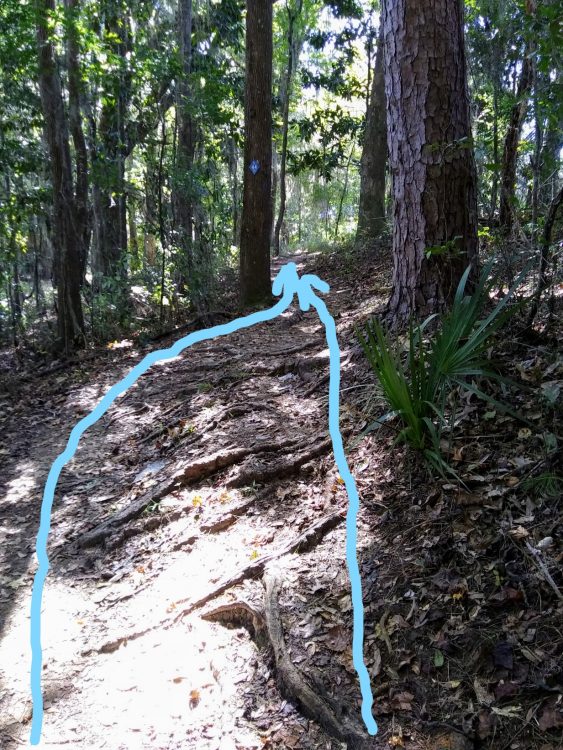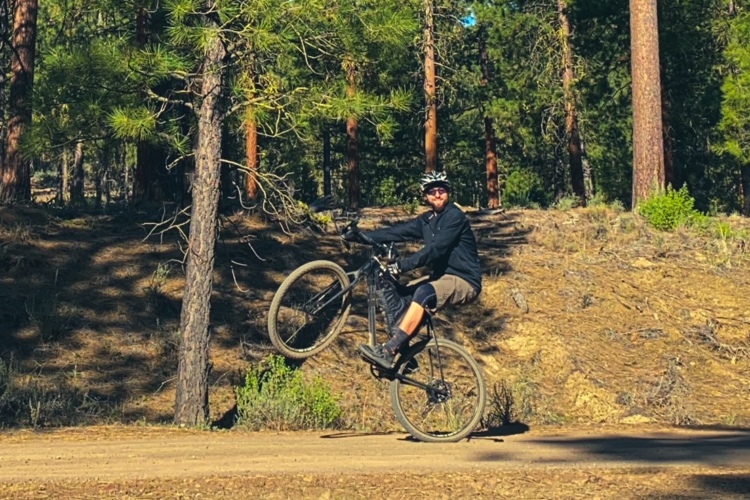
Wet or dry, roots can be intimidating. The uneven surface and odd angles at which they spread out over the trail demand precision in form and technique. Add moisture to the mix and things become even more challenging. The leftover condensation from the previous day’s rain or a foggy morning that makes the dirt tacky and grippy has the opposite effect on roots. They become slick as a slab of ice and create even more uncertainty about where to place the bike so it travels straight over them without getting tossed to one side of the trail.
Recently, my riding partner and I were out on a morning ride when the trail conditions were damp. As we rode over a section of roots, I went from seeing the back tire of my partner’s bike to the entire side profile of it in a split second. Incredibly, he managed to catch it and continue without crashing, but we were both rattled by the experience. It took us a few rides afterward before we regained the confidence to ride over them again.
After he gave me such great advice on riding in loose/sandy conditions for a previous article, I called on Jeremiah “Scratch” Stone, an MTB instructor and trail builder who works with Ninja Mountain Bike Performance to provide Singletracks readers with tips for riding over wet roots. Here are his suggestions for conquering these sketchy trail features.
Wet roots are less intimidating once you pick a line
Stone sympathizes with any rider’s hesitancy to ride over roots. “Roots are a mental block for so many riders — they see them and in their mind it’s a rolling of the dice type of gamble! But I think it’s like so many other things in MTB — if you have a plan, you can ride with intention and then train your reactions properly.”
Riders first need to understand why roots cause their bikes to get squirrely. “With roots, it helps to narrow down what causes the bobbles. It can usually be traced back to a stiff or off-balance body position.” Poor body position is usually the byproduct of a rider’s fear about riding over a feature that intimidates them. “Think about what happens when something scares or surprises us on the bike — we stiffen up, close in our elbows and knees, and scoot back to get away from the scary thing.”
To counteract the tendency to stiffen up when approaching roots, Stone suggests riders first train their reaction to them. “Get low, wide, and centered where you and the bike can move and groove. Then when a root kicks you around a few inches, the bike is still underneath you and you’re still in control and balanced.”
Next, Stone encourages riders to focus on their line choice. “Get those eyes up! Learn to identify the more disruptive roots rather than try to stare down every single one. Note where the taller and off-angle ones are — those are the disruptors. Think about how bad you’ve been treated by some 45-degree roots. Choose a line that lets you hit the roots more perpendicular if possible. If they’re all angled or off-camber, consider using a high arcing line so that if the bike shifts/ slides down, you’re still on the trail.”
Building skills and having options can also allow riders to conquer wet roots
While riders should have some measure of faith and hope, this shouldn’t be the only tool in their toolbox according to Stone. He advises riders “learn to time and use a strong compression before the roots so that you can get lighter as you roll over the roots. Then, develop a bunny hop that might let you hop over a section. From there, and my personal favorite, use an early root as a ‘bump jump’ to give you the option of boosting further — line selection is 3-dimensional!”
Bike setup is an important component for successfully navigating wet roots too
While planning and developing skills are key ingredients for conquering wet roots, Stone reminds riders to also pay attention to their bike setup. “Make sure your baseline is right first! Lowering the tire pressure a few PSI can help, but don’t go too low or you’ll risk pinch flats, snakebites, or rim dings. Sometimes a softer pressure in the shock helps (5-10psi if there are less big hits/ bottom out spots on the ride). Also, for wet roots, slowing the rebound by a click or two can help some.”
I can personally attest to the benefits of making these changes. The lower tire pressure gives you a wider contact patch with the trail. The lower air pressure in your suspension helps your wheels stay planted to the ground, as does slowing the rebound by just a click or two. Making simple adjustments like these to your bike setup in conjunction with the proper skills and planning makes for a winning combination when it comes to riding over wet roots.














9 Comments
Nov 23, 2021
Nov 24, 2021
Nov 23, 2021
Nov 25, 2021
Nov 25, 2021
Nov 27, 2021
Nov 28, 2021
Dec 1, 2021
Nov 25, 2021